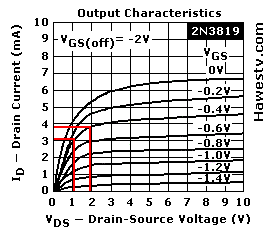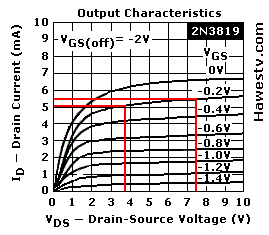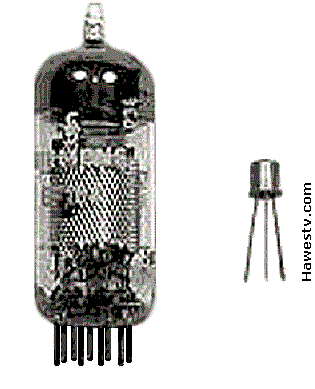Are FETs Really Like Tubes?
Are FETs really like tubes? The short answer is YES! As preamplifiers, JFETs and depletion MOSFETs behave a lot like pentodes. There are depletion power FETs that act the like tubes, too. For example, the DN2540 by Microchip.
How do triodes compare? For those who love triode tubes because of their lovely, even harmonics: Every JFET comes with a built-in Triode Mode. So does every depletion MOSFET. We'll go into these ideas later on this page. For now though, the bottom line is this: Nothing is exactly like a tube, except another tube. But JFETs and depletion MOSFETs are as close as semiconductors come. And that truth makes them attractive. Plus, they have their own advantages...
| Advantages: JFETs and Depletion MOSFETs are... | ||
|
|
|
Further questions. Still, if you're technical, you have further questions. That's why we're here. Please read on...
Why don't FETs have an RP or a Mu (µ) rating? Datasheets often do offer some of this data. But unfortunately, manufacturers bury the data. Here, we reveal how to recover this obscure information. You can then apply Hendrik van der Bijl's famous tube formula to FETs. (1.) This is the formula...
µ= (GM x RP)
Where
- µ= Amplification factor or Mu
- GM= Transconductance
- RP= Plate Resistance
When we apply the formula to FETs, it becomes...
µ= (GM x RD) Where
- RD= Drain Resistance
Of course, FET datasheets don't include RD. Yet Malvino points out that drain resistance RD is the reciprocal of output transconductance, the variable GOS. And variable GOS does appear on many datasheets. (2.) (Note that some datasheets name this same variable YOS. Nothing like standardization!)
Amplification factor, µ doesn't appear. But now, we can calculate it!
First, we adapt the formula to what we find on datasheets...
µ= [GM x (1 / GOS)]= (GM x RD) Where
- GOS= Output Transconductance
- Transconductance (GM)= Inverse Resistance
Example...
| For FET type: 2N4338 (using max GM & max GOS) | |||
| GM | RD | µ | |
| 1.8 mS | 200 KΩ | (0.0018 x 200,000)= 360 | |
Compare that example to a vacuum tube...
|
For tube type: 12AX7, one section
(using specs for “typical operation” at 250V) |
|||
| GM | RP | µ | |
| 1.6 mS | 62,500 Ω | (0.0016 x 62,500)= 100 | |
Pentode Mode vs. Triode Mode
Fair play. Actually, the “JFET-tube comparison” above isn't exactly fair. Sure, a JFET has three electrodes, just like a triode does. But the JFET normally behaves like a pentode. That statement assumes that the drain potential is above the pinch-off voltage. Then the device is a voltage-controlled current source, a “pentode.” (With the drain below the pinch-off voltage, the device is a voltage-controlled resistor, a “triode.” The same rules apply to depletion MOSFETs.)
Beyond pinch-off, the JFET drain (plate) voltage ceases to affect drain current. Instead, the drain current remains constant. This behavior is the way a pentode acts, but unlike triode behavior. And the 12AX7 that we used in our example is a triode. So let's rethink the 12AX7 comparison, and check out the performance of a pentode, the 6J7...
|
For tube type: 6J7
(using specs for “pentode connection”) |
|||
| GM | RP | µ | |
| 1.185 mS | 1M | (0.001185 x 1M)= 1185 | |
Maybe a bit more like our JFET. The 6J7 has a high plate resistance and high transconductance, just as our JFET has. Possible conclusion: The JFET is “just like” a pentode. But not so fast! Unlike a pentode, our JFET has two modes of operation. So far, we've only looked at one of these. Here are the two...
- Pentode, or Constant-Current Mode, the usual state.
- Triode, Ohmic, or Linear Mode, where the device behaves like a triode.
Coping with incomplete data. In a minute, we'll have more about Triode Mode. But first, we need to solve another problem that might have occurred to you: What if your datasheet doesn't include a GOS rating? How can you obtain the drain resistance value? Answer: There's a simple trick with Ohm's Law.
Find the AC value of RD
|
• NOTICE. There are two types of drain resistance: DC and AC. AC drain resistance (RP) is useful in amplifier design. RP requires four measurements and a calculation. This section discusses the calculation method. Calculating DC plate resistance is a simpler process...
This section proceeds with how to determine the AC drain resistance. |
Using Ohm's LawIf your datasheet doesn't provide the GOS value, you can still find the drain resistance. Use Ohm's Law this way (3.)...
|

Fig. 1. Pick ID & VD values on the drain curve graph. (Here, using Triode Mode curves.) (4.) |
- Drop down to the X-axis, and check that the drain voltages are what you wanted. (In our example, 1V and 2V.)
- Compute the difference between the two voltage values.
- Pick two drain current values on the desired curve.
- Move left to the Y-axis, and check that the drain currents are what you wanted. (In our example, 3.0 mA and 3.8 mA.)
- Compute the difference between the two current values.
- Convert the difference mA to A (Divide by 1,000).
- Divide the voltage difference value by the current difference value (in amps). The result is your AC plate resistance at the selected points. (Below is the formula.)
Use Ohm's Law RD= (ΔVD / ΔID)
Example (with values from Fig. 1)
High Low Dif Rd 2V 1V 1V 1,250 3.8mA 3.0mA 0.8mA
Calculations (0.8mA / 1,000)= 0.0008A
RD= (1V / 0.0008A)
RD= 1,250Ω• NOTICE
The symbol Δ stands for “a change in.” We also know this symbol as “delta.”
RD Calculation, Pentode Mode Example
Pentode Mode ExampleFinding RD inside Pentode Mode may be more difficult than in Triode Mode. The reason for the difficulty is the flatness of the curves in Pentode Mode. Yet there is some slight curvature. To achieve a meaningful RD value, choose widely separated voltage and current points. See the red lines in the example, right. (5.) |

Fig. 2. Pick ID & VD values on the drain curve graph. (Here, using Pentode Mode curves.) (6.) |
|
Calculations
(0.5mA / 1,000)= 0.0005A
RD= (3.7V / 0.0005A) RD= 7,400Ω |
|
| ♦ CAUTION: Precision. Calculating RD from the small curve sets on datasheets can produce inaccurate results. If possible, rely instead on the GOS figure that some manufacturers supply. Inverting this GOS figure allows you the precision of a factory RD spec. Yet also note that specs for DFET devices (JFETs and depletion MOS devices) vary widely. (Often by five to one). |
How do engineers harness the Triode Mode? How can I build a Triode-Mode preamp? Visit our next page!
Footnotes
1. Alfred A. Ghirardi, Radio Physics Course, 2nd ed. New York: Technical Division, Murray Hill Books Inc.: 1932, 419. ▶Re: Vacuum tube formula relates transconductance, amplification factor, and plate resistance.
2. Albert Paul Malvino, PhD, Electronic Principles, Second Edition. (New York: McGraw-Hill Book Company, 1979), 330. ▶Re: Parameter GOS is the reciprocal of drain resistance.
3.
George J. Christ, Radio Tube Fundamentals,
Bradley, IL: Lindsay Publications, 2008, 24-27.
(Original Publisher: NY:
Gernsback Publications, Inc., 1951.)
Short URL: shorturl.at/imrS4 (Reprint edition)
Short URL: https://is.gd/Oeln3Z (Original edition)
Order One: tinyurl.com/mr37t8d4 (Amazon.com listing)
▶Re: How to derive AC plate (drain) resistance from
characteristic (drain) curves for the JFET. Example uses
Triode Mode area of curves.
4.
Vishay Siliconix, 2N3819, document 70238, S-04028, Rev. D
(Sunnyvale, CA: Vishay Siliconix LLC, 2001).
▶Re: My datasheet
overlay demonstrates how to find variable values for the Ohm's Law calculation
of RD. The Datasheet is for a type 2N3819, N-channel JFET. The
original manufacturer was Siliconix. Siliconix obsoleted the part, but
other semiconductor foundries still manufacture the 2N3819. Examples:
Central Semiconductor, InterFET, and On Semiconductor.
5.
Christ, Radio Tube Fundamentals, 24-27.
Short URL: shorturl.at/imrS4 (Reprint edition)
Short URL: https://is.gd/Oeln3Z (Original edition)
Order One: tinyurl.com/mr37t8d4 (Amazon.com listing)
▶Re: Deriving AC value of RD in Pentode
Mode area of curves.
6.
Vishay Siliconix, 2N3819, document 70238, S-04028, Rev. D.
▶Re: My datasheet
overlay demonstrates how to find RD in Pentode Mode.
Go to Page: 1 2 3 4 5 6 Next
Contents
Figures
